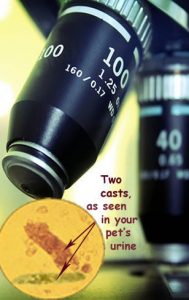Ron Hines DVM PhD
Casts Seen Microscopically In Your Dog Or Cat’s Urine
Urine casts are cylindrical microscopic structures composed of cellular debris and protein that originated from the cells that line the lower portions of the tiny tubes (aka tubules) that compose much of your dog or cat’s kidneys. The presence of casts, when extensive, is unnatural, and it is thought that they form when these tubule cells are injured. Depending on their components and shape, they are called cellular, granular, waxy or fatty casts. When they are present, these casts will be found in the sediment that accumulates at the bottom of a test tube of your pet’s urine once it has been spun in a centrifuge and examined by your veterinarian or lab tech, under a microscope (cloudy or turbid urine is not, in itself, evidence that casts are present).
The fact that no casts were found is not sufficient to rule out kidney disease in your dog or cat. But the fact that casts are there is evidence that the pet has a kidney health issue.
The longer a urine specimen sits before examination, the less likely that casts that were once present will still be seen.
DxMe
You are on the Vetspace animal health website
Visiting the products that you see displayed on this website help pay the cost of keeping these articles on the Internet.
